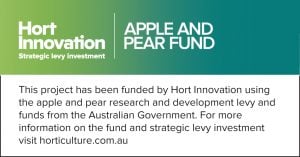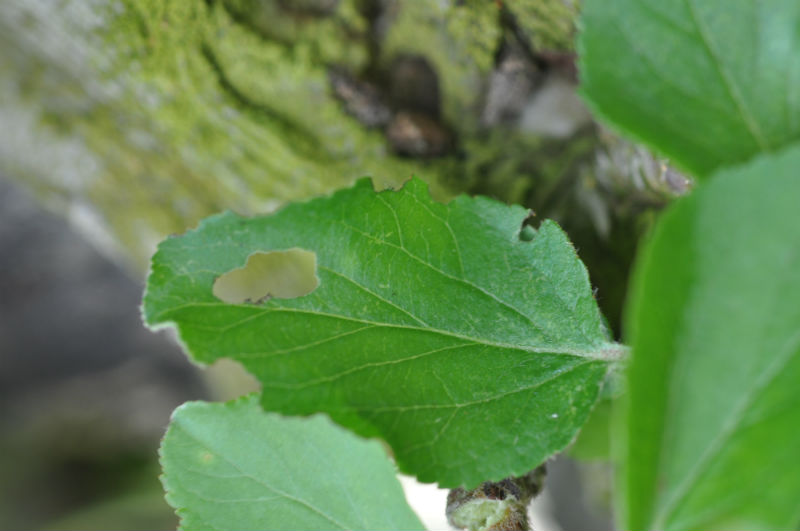Out of a recent survey and discussions at workshops in August the most mentioned pests of concern in Western Australia were med fly, weevils, woolly aphids, mites and thrips.
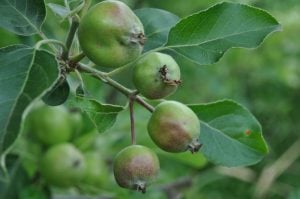
Depressions in apple fruitlets caused by apple dimpling bug
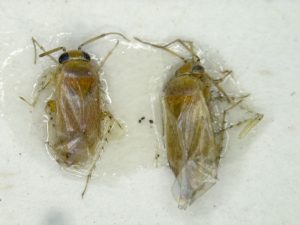
Adult apple dimpling bug
For pests that may or may not be a problem in spring, regular monitoring will indicate whether action is required. History of the orchard, especially damage the previous season, will indicate what pests are likely to occur and therefore need regular monitoring. For example, pests such as apple dimpling bug and garden and apple weevil vary in abundance each season. If these pests are present above the action threshold, monitoring will dictate the best time to intervene.
Knowing what monitoring technique to use is important.
- For apple and garden weevils monitor weekly using corrugated cardboard bands on tree trunks or check for scalloped leaves near the crown of trees from late October to December.
- For apple dimpling big, weekly tapping blossoms into an ice cream container works well. If low numbers are found, monitoring frequency should be increased to twice a week.
- For Western flower and plague thrips sample at the same time as ADB. Sample before 9am as the thrips become too active to be easily identified once the air temperature rises.
- For apple rust mites, european red mites and bryobia mites start monitoring for adults and nymphs from November through to February. For two-spotted mite continue monitoring until harvest.

Monitor for garden weevil by checking for the characteristic leaf scalloping
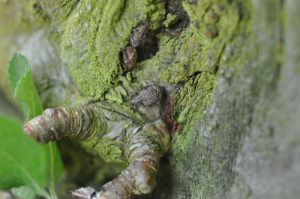
Adult weevils which seek a sheltered site during the day
IPDM is a systematic approach to pest and disease management. It incorporates identification and monitoring of pests and their natural enemies, and diseases, and techniques such as cultural practices and selective chemicals that allow natural enemies to keep pest populations under control. The IPDM decisions reduce crop damage while helping to reduce environmental impact and at least maintain and hopefully improve returns. It is all about deciding on the acceptable damage levels, which vary between orchards, and identifying when the cost of preventing loss will be higher than the value of potential loss.
An example of an IPDM strategy used is the woolly aphid wasp. The wasp parasitises the aphids by laying their eggs into them. Instead of the aphid developing as normal a ‘mummy’ forms, from which a wasp emerges. If you have aphid mummies in your orchard they can be collected in autumn, stored in the fridge or cool room and then released into the orchard the coming season in late spring when woolly aphids colonise tree canopies. To collect the mummies simply prune wood with parasitised aphids.
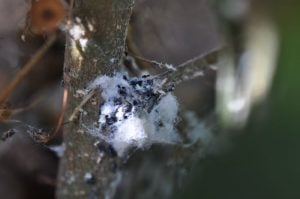
An infestation of woolly aphid on the stem of an apple tree with the small wasp parasite to the right and above the aphids and numerous aphid ‘mummies’ – aphid shells with an emergence hole through which a parasitic wasp emerged.
The survey and workshops were conducted as part of the Hort Innovation Australia funded project “AP16007: An Integrated Pest, Disease and Weed Management (IPDM) program for the Australian Apple and Pear Industry”
For more information contact Alison Mathews from DPIRD [email protected], 9777 0122 or Susie Murphy White from Pomewest [email protected], (08) 9777 0151
Further information links
https://www.agric.wa.gov.au/pome-fruit/managing-apple-dimpling-bug
https://www.agric.wa.gov.au/pome-fruit/miticides-wa-deciduous-fruit-trees
https://www.agric.wa.gov.au/pome-fruit/garden-weevil-vineyards
https://www.agric.wa.gov.au/pome-fruit/management-european-red-mite-western-australia
https://www.agric.wa.gov.au/pome-fruit/thrips-pests-pome-and-stone-fruit
